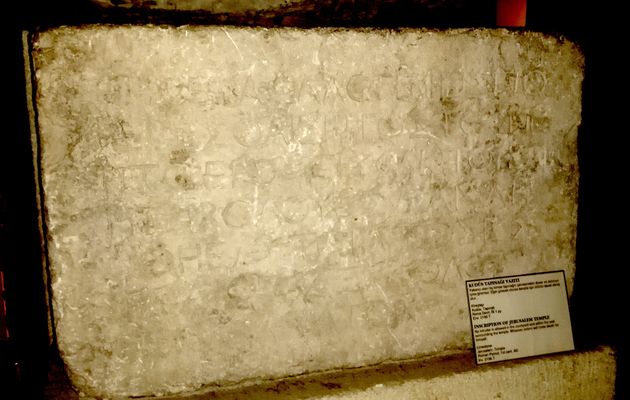The author of Ephesians makes the point that in Christ the barriers between God and humanity, and the artificial barriers that people have put up against each other are destroyed.
 The Thanatos Inscription. Istanbul Archaeology Museum. / Marc Madrigal
The Thanatos Inscription. Istanbul Archaeology Museum. / Marc Madrigal
In 1871 Charles Clermont-Ganneau discovered an inscription in Jerusalem dating from the period of the Herodian Temple. Inscribed in a slab of stone was a warning written in Greek, the international language during the time of Jesus.
The inscription read:
“No foreigner is allowed to enter the courtyard and enclosure surrounding the temple. Whoever is caught will be responsible to himself for his death, which will ensue.”
This inscription was one of the series of warnings placed in the temple courts. The temple courts were divided into several sections. The outer courtyard was known as the court of the Gentiles.
The inner courtyard was divided into three: the court of the women, the court of Israel (reserved for men), and finally the court of the priests. Inside the court of the priests lay the actual temple sanctuary with the famous holy place and the holy of holies.
No doubt, approaching God was a highly class-structured business. Non-Jews were not allowed to go beyond the courtyard of the Gentiles, and the death warning made sure this was so.
In Book V of the War of the Jews, Jewish historian Flavius Josephus gives us details regarding this courtyard and the inscription itself:
“The cloisters [of the outmost court] were in breadth thirty cubits; while the entire compass of it was by measure six furlongs: including the tower of Antonia. Those entire courts that were exposed to the air were laid with stones of all sorts. When you go through these [first] cloisters, unto the second [court of the] temple, there was a partition made of stone, all round; whose height was three cubits, its construction was very elegant. Upon it stood pillars, at equal distances from one another; declaring the law of purity, some in Greek and some in Roman letters; that no foreigner should go within that sanctuary. For that second [court of the] temple was called the sanctuary”. (War of the Jews, Book V. Chapter 5;2)
Although not mentioned directly in the New Testament, there are two passages where implicitly these walls of division play a role.
The first passage is in Acts 21:27-29.
An angry mob accused Paul of taking Trophimus, Paul’s Ephesian friend, into the inner temple courts. This resulted in Paul’s arrest and his eventual fourth journey which ended in Roman house arrest:
“When the seven days were almost completed, the Jews from Asia, seeing him in the temple, stirred up the whole crowd and laid hands on him, crying out, “Men of Israel, help! This is the man who is teaching everyone everywhere against the people and the law and this place. Moreover, he even brought Greeks into the temple and has defiled this holy place”. For they had previously seen Trophimus the Ephesian with him in the city, and they supposed that Paul had brought him into the temple”. (ESV).
The second passage alluding to this wall is in Ephesians 2:14-16:
“For he himself is our peace, who has made the two groups one and has destroyed the barrier, the dividing wall of hostility, by setting aside in his flesh the law with its commands and regulations. His purpose was to create in himself one new humanity out of the two, thus making peace, and in one body to reconcile both of them to God through the cross, by which he put to death their hostility” (ESV)
The diving wall of hostility seems to be an allusion to the walls of the temple court. The author of Ephesians makes the point that in Christ the barriers between God and humanity, and the artificial barriers that people have put up against each other are destroyed.
Christ is the one that reconciles individuals with one another, and he is also the one that reconciles individuals with God.
In Christ, a new humanity is created. As Paul puts it in Galatians 3:28, “There is neither Jew nor Greek, there is neither slave nor free, there is no male and female, for you are all one in Christ Jesus”. (ESV)
In our 21st century world, we often forget how radical these statements were. Roman society was highly class-structured. Women had limited rights and slaves had no citizenship whatsoever. To believe in the equality of all individuals under Christ regardless of gender, class or ethnicity is nothing short of revolutionary. In Christ, all have access to the holy of holies.
And yet, the history of the church is filled with dark chapters where walls have been built time and time again: Walls of nationalism, walls of racism, walls of denominationalism, to name a few. Sometimes these walls are built for the sake of self-preservation, sometimes to create a “holier than thou” type of environment.
Whatever the reasons, we seem prone to fall back to the first-century Jewish ways of approaching the temple. And while men might be in the business of building up walls of death, God is in the business of bringing them down by offering life through Christ.
Marc Madrigal is a Board member in the Istanbul Protestant Church Foundation in Turkey.
BIBLIOGRAPHY
Clyde E. Fant; Mitchell G. Reddish. Lost Treasures of the Bible: Understanding the Bible through Archaeological Artifacts in World Museums (Kindle Locations 4209-4210). Kindle Edition.
Pasinli, Alpay. Istanbul Archaeological Museums. A Turizm Yayinlari. Istanbul, 2012.
Whiston, William; M.A. The Genuine Works of Flavius Josephus The Jewish Historian. London, 1737. http://penelope.uchicago.edu/josephus/war-5.html

Las opiniones vertidas por nuestros colaboradores se realizan a nivel personal, pudiendo coincidir o no con la postura de la dirección de Protestante Digital.
Si quieres comentar o